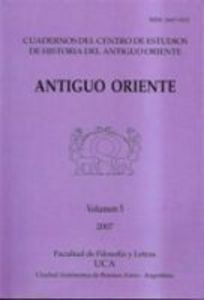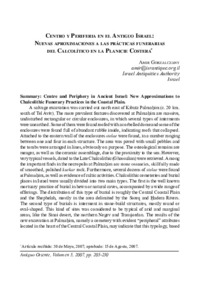Por favor, use este identificador para citar o enlazar este ítem:
https://repositorio.uca.edu.ar/handle/123456789/11886| Título: | Centro y Periferia en el Antiguo Israel: Nuevas aproximaciones a las prácticas funerarias del Calcolítico en la Planicie Costera Centre and Periphery in Ancient Israel: new approximations to chalcolithic funerary practices in the Coastal Plain |
Autor: | Gorzalczany, Amir | Palabras clave: | YACIMIENTOS ARQUEOLOGICOS; OBJETOS ARQUEOLOGICOS; RITOS FUNERARIOS; CEMENTERIOS | Fecha de publicación: | 2007 | Editorial: | Pontificia Universidad Católica Argentina. Facultad de Ciencias Sociales. Departamento de Historia. Centro de Estudios de Historia del Antiguo Oriente | Cita: | Gorzalczany, A. Centro y Periferia en el Antiguo Israel: Nuevas aproximaciones a las prácticas funerarias del Calcolítico en la Planicie Costera [en línea]. Antiguo Oriente. 2007 (5). Disponible en: https://repositorio.uca.edu.ar/handle/123456789/11886 | Resumen: | Summary: Centre and Periphery in Ancient Israel: New Approximations to
Chalcolithic Funerary Practices in the Coastal Plain.
A salvage excavation was carried out north east of Kibutz Palmahim (c. 20 km.
south of Tel Aviv). The more prevalent features discovered at Palmahim are massive,
undisturbed rectangular or circular enclosures, in which several types of interments
were unearthed. Some of them were found roofed with a corbelled dome and some of the
enclosures were found full of abundant rubble inside, indicating roofs that collapsed.
Attached to the eastern wall of the enclosures stelae were found, in a number ranging
between one and four in each structure. The area was paved with small pebbles and
the tombs were arranged in lines, obviously on purpose. The osteological remains are
meager, as well as the ceramic assemblage, due to the proximity to the sea. However,
very typical vessels, dated to the Late Chalcolithic (Ghassulian) were retrieved. Among
the important finds in the necropolis at Palmahim are stone ossuaries, skillfully made
of smoothed, polished kurkar rock. Furthermore, several dozens of stelae were found
at Palmahim, as well as evidence of cultic activities. Chalcolithic cemeteries and burial
places in Israel were usually divided into two main types. The first is the well known
mortuary practice of burial in hewn or natural caves, accompanied by a wide range of
offerings. The distribution of this type of burial is roughly the Central Coastal Plain
and the Shephelah, mostly in the area delimited by the Soreq and Hadera Rivers.
The second type of burials is interment in stone-build structures, mostly round or
oval-shaped. This kind of sites was considered to be typical of arid and marginal
areas, like the Sinai desert, the northern Negev and Transjordan. The results of the
new excavation at Palmahim, namely a cemetery with evident “peripheral” attributes
located in the heart of the Central Coastal Plain, may indicate that this typology, based on geographical distribution is no longer valid. This could alter our understanding of
Chalcolithic burial practices. Resumen: Centro y periferia en el Antiguo Israel: Nuevas aproximaciones a las prácticas funerarias del Calcolítico en la Planicie Costera. Se realizó una excavación de rescate al noreste del Kibutz Palmahim (c. 20 kilómetros al sur de Tel Aviv). Los rasgos más frecuentes descubiertos en Palmahim son recintos rectangulares o circulares imperturbados, en los cuales fueron descubiertos varios tipos de enterramientos. Algunos de ellos fueron encontrados cubiertos con una bóveda en voladizo, y algunos de los recintos fueron encontrados llenos de abundantes escombros, indicando techos que se derrumbaron. Unidas a la pared oriental de los recintos, se encontraron estelas, en un número que se extendía entre uno y cuatro en cada estructura. El área fue pavimentada con pequeños guijarros y las tumbas fueron dispuestas en línea, obviamente a propósito. Los restos osteológicos son pobres, así como el conjunto cerámico, debido a la proximidad del mar. Sin embargo, fueron recuperados recipientes muy típicos, datados a fines del Calcolítico (Ghasuliense). Entre los importantes hallazgos en la necrópolis de Palmahim están los osarios de piedra, hechos hábilmente de roca kurkar alisada y pulida. Además, en Palmahim fueron encontradas varias docenas de estelas, así como evidencias de actividades cúlticas. Los cementerios del Calcolítico y los lugares de enterramiento en Israel fueron divididos generalmente en dos tipos principales. El primero es la práctica mortuoria bien conocida del enterramiento en cuevas cavadas o naturales, acompañada por una amplia gama de ofrendas. La distribución de este tipo de enterramientos es aproximadamente la llanura costera central y la Shefelá, sobre todo en el área delimitada por los ríos Soreq y Hadera. El segundo tipo de enterramiento es el entierro en estructuras hechas de piedra, mayormente de forma redonda u oval. Esta clase de sitios era considerada típica de áreas áridas y marginales, como el desierto del Sinaí, el Negev septentrional y Transjordania. Los resultados de la nueva excavación en Palmahim, esto es, un cementerio con características evidentemente “periféricas” situadas en el corazón de la llanura costera central, pueden indicar que esta tipología, basada en la distribución geográfica, ya no es válida. Esto podría alterar nuestra comprensión de las prácticas de enterramiento del Calcolítico. |
Cobertura Espacial: | Israel | URI: | https://repositorio.uca.edu.ar/handle/123456789/11886 | ISSN: | 1667-9202 | Disciplina: | HISTORIA | Derechos: | Acceso abierto | Fuente: | Antiguo Oriente Vol.5, 2007 |
| Aparece en las colecciones: | AO - 2007 nro.5 |
Ficheros en este ítem:
| Fichero | Descripción | Tamaño | Formato | |
|---|---|---|---|---|
| antiguo_oriente05.jpg | 6,54 kB | JPEG |  Visualizar/Abrir | |
| centro-periferia-antiguo-israel.pdf | 300,25 kB | Adobe PDF |  Visualizar/Abrir |
Visualizaciones de página(s)
104
comprobado en 30-abr-2024
Descarga(s)
84
comprobado en 30-abr-2024
Google ScholarTM
Ver en Google Scholar
Este ítem está sujeto a una Licencia Creative Commons

